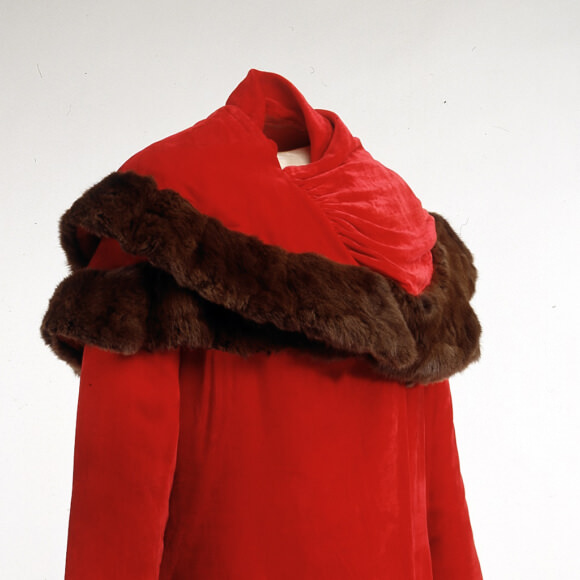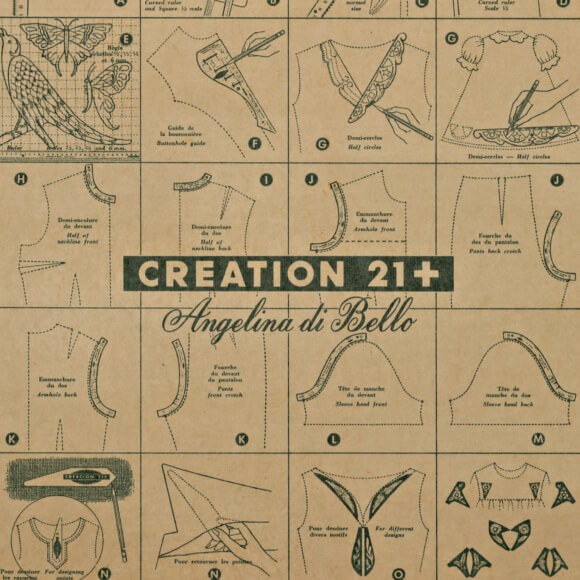Having worked in turn as an illustrator, designer and artistic director, Denis Desro made his mark as fashion editor of the magazines ELLE Québec and ELLE Canada, from 1993 to 2015.
Recognized on the international fashion scene, for over two decades he played a major role in covering and promoting fashion from Montreal and around the world to a wider public.
Denis Desrosiers showed an early aptitude for sewing and design. Moving to Montreal, he earned a certificate in fashion design from École Alyne Larin in 1974. He followed this with a diploma of college studies in visual arts from Cégep du Vieux Montréal (1977) and a bachelor’s degree in graphic design from UQAM (1982). After finishing his studies, he worked on multiple freelance projects in fashion design, illustration, graphic design and styling, notably for the magazine Nous, the Grands Ballets Canadiens and Québec 84.
In the exciting early 1980s, Desro regularly worked with window dresser and star artistic director Dick Walsh. He designed tableaux for some of Walsh’s extravagant fashion shows, did hairstyling for Serata Fellini, a soirée at Montreal’s celebrated Régine’s night club to mark the launch of the 1980 Montréal World Film Festival, and made outfits for a fashion show celebrating New Year’s 1982, under the theme Berlin cabaret. In addition to doing an apprenticeship at the Givenchy atelier in Paris, he worked in fashion advertising in Milan for clients like Versace and Ferré, seeing his work published in the magazines Donna and Linea. He taught fashion design at LaSalle College (1982-1983) and, from 1983 to 1989, had illustrations published in The Gazette.
He created his first mini-collection as a designer in 1973 under the name Desro, a shortened form of his surname that he used throughout his career. These early works demonstrated his European-style taste, ingenuity, and a perfectionism epitomized by the use of noble materials and impeccable tailoring. For his muse and future associate Denise Habel, he produced a number of original outfits, imbued with femininity, which she would wear to their evenings out at the very hip Limelight disco. In the mid-1970s, some of his creations—suits and dresses with oversized shoulders—made their way to Los Angeles.
In September 1986, he launched his first official collection, which was initially sold in Ingrid’s Boutique, a Montreal clothing store that sold many imports, as well as in New York City. At the time, he used a lot of wool jersey, in dark colours, to design form-fitting clothing that, as he said, “should not overpower the personality of the woman who wears it.” In October, the American edition of ELLE magazine named him one of the new designers to watch. The following year, in Quebec City, he opened the International Fashion Show at Rendez-Vous 87 with his designs inspired by the theme of royalty.
A highlight of the decade was Desro winning the prestigious Fil d’Argent award at the 1989 International Linen Festival in Monte Carlo, having helped create the fabrics used in his collection.
Describing the designer who created clothing for “passionate, extraordinary women who do not compromise,” Anne Richer, fashion journalist at newspaper La Presse, wrote the following: “His garments have interesting lines to explore, promising a constant search for new adventures, but exhibit the discipline of someone who knows his profession and the perfectionism of someone who has studied in Europe.”
In 1993, Desro became the fashion editor of ELLE Québec (founded in 1989)—subsequently taking on the same responsibility for ELLE Canada when it was launched in 2001—and adopted the meticulous work methods that would lead to his success, reputation and longevity.
Season after season, he would unflaggingly and enthusiastically attend fashion shows in Paris, Milan, New York, Toronto and Montreal, sitting through about 80 shows in all and reviewing over 7,000 creations to determine predominant trends and identify essential pieces. Daily newspapers from across Canada would also call on his rare expertise for comments about seasonal trends and the feminine archetypes presented on the runway.
“At fashion shows, I am primarily looking for an emotion,” he once confided in an interview. That being said, he did focus on the clothing to establish the themes of his articles. “My job is to interpret the trends we see in the shows to help our readers integrate them into their everyday wardrobes,” he noted. This prosaic aim did not prevent him from creating polished, striking images that looked like paintings, full of stories and atmosphere, that were nonetheless always respectful of the models. His photo shoots were designed to be of international calibre, and he often staged them in unusual locations like a vintage camper, hunting camp, merry-go-round or abandoned hotel. His imagination was implicitly fuelled by the 1940s and 1950s, legendary fashion figures like Dior, Balenciaga and Yves Saint Laurent, stars like Grace Kelly and Brigitte Bardot, divas, and ultra-femininity, along with his sense of refinement and penchant for the school of Belgian designers and Japanese designers.
Over the years, his distinct aesthetic was displayed in the pages of ELLE magazines around the world on numerous occasions and recognized by multiple awards from groups like Magazines du Québec, the Association québécoise des magazines, the Canadian National Magazine Awards Foundation and Infopresse.
With an awareness of emerging social issues and an eye for faces and silhouettes that anticipated the evolution in the way women’s bodies are presented in the media, Desro was also behind numerous defining visuals and firsts. Some examples: Canadian supermodel Daria Werbowy gracing the cover of ELLE Québec early in her career (2001); Justine LeGault, the first Quebec-born plus-size model to grace the front cover of a Quebec fashion magazine (2013); “Pearls rondes,” a pioneering article featuring healthy curvaceous models (1997); “Noir fatal,” a profile of plus-size model Ashley Graham (2014), which caused a stir on both sides of the Atlantic; and glamorous tributes to motherhood (1997), pregnancy (2003), authentic couples (2006) and women ages 14 to 64 posing with healthy confidence (2013). Not to mention the cover celebrating ELLE Quebec‘s 25th anniversary (2014), spotlighting the naked grace of five Quebec models.
Though always looking to offer his readers a window onto the world of international fashion, Desro also made a point of showcasing Quebec and Canadian designers who met his high standards and stood out for their originality and excellence.
For example, he found Denis Gagnon to be a worthy successor to Georges Lévesque. Year after year, Desro would celebrate the work of designers like Yso, Renata Morales, Mélissa Nepton, Marie Saint Pierre and Philippe Dubuc, while deploring the lack of technical and financial resources available to them.
A mentor always on the lookout for new talent, Desro boosted the careers of many associates.
His loyal right hand, stylist Anthony Mitropoulos; photographers Raphael Mazzucco, Leda & St.Jacques, Dimitri Mavrikis, Jean-Claude Lussier, Richard Bernardin, Patrice Massé, Owen Bruce, Chris Nicholls and Nelson Simoneau; hairstylist and makeup artist Paco Puertas; stylists Véronique Delisle, Chloé Legault, Isabelle Long and Sara Bruneau are just some of the artists whose work was regularly featured in the pages of the magazines under his direction.
For the 25th anniversary of ELLE Québec, Desro revisited his past career as a designer and worked with RW & Co. to design a limited edition collection of eight affordable holiday dresses inspired by the 1960s and 1970s, for women of all shapes and sizes. The capsule collection was so successful and that the idea was repeated the following spring.
Desro always accepted invitations to sit on panels to introduce young people to the inner workings of his profession, like the January 2010 conference for students at UQAM’s École supérieure de mode, where he was greeted like a rock star. Most importantly, as early as 2011 he recognized the reach of social media and the evocative power of images, posting almost daily on Twitter and Instagram. “With Twitter, you can build your own world,” he noted. “I like to tweet photos before, during and after fashion shows and photo shoots.”
Following his 2015 departure from ELLE Québec and ELLE Canada, Desro worked on various campaigns for La Maison Simons as a stylist and artistic director. In 2019, he dressed Quebec country singer Matt Lang for a series of photos by Carl Lessard, in addition to serving as artistic director. The same year, Quebec singer Marie Mai asked him to work on the music video for The Good Ones, her duet with Canadian country artist Tebey. Still working, Desro died of complications following a heart attack on April 4, 2020.
Immediately recognizable with his perfectly tousled hair, statement glasses, unbuttoned cuffs and well-tailored jackets, he has left an extraordinary legacy in the Quebec and Canadian fashion industry.
His authentic artistic vision, unerring eye for the latest thing, assured taste and in-depth knowledge of style and cut, along with his demanding work ethic, combined to create striking, sometimes dreamlike, sometimes graphic, visuals that are now references in the industry.
The curiosity, enduring passion and critical judgment of this soft-spoken designer with a sharp wit will remain a model and inspiration for many.
Sources
Bulletin de la Faculté des arts, “L’École supérieure de mode reçoit Denis Desro,” UQAM | Faculté des arts, January 26, 2010, http://bulletin-arts.uqam.ca/archives/2010.01.26/1676/.
Couzinou, Véronique. “Parlons mode avec Denis Desro,” ELLE Québec, January 8, 2006, https://www.ellequebec.com/mode/tendances/parlons-mode-avec-denis-desro. Internal link
Denis Desro interviewed at the 2012 Montreal Fashion Week: “Denis Desro : rencontrez le rédacteur en chef mode : Elle Québec,” districtmode.ca : sous les feux de la passerelle et dans l’arrière-scène, https://vimeo.com/36533296. Internal link
Djogo, Martina (interviewer). “Flashback sur la mode,” ELLE Québec, October 2014, p. 116-128.
Gagnon-Paradis, Iris. “Denis Desro n’est plus,” La Presse, April 7, 2020, https://www.lapresse.ca/societe/mode-et-beaute/2020-04-07/denis-desro-n-est-plus. Internal link
Hubbard, Jaimie. “It’s sew fine: Increased international recognition is becoming the pattern for Canadian designers,” National Post, April 20, 1987, p. 33.
“Merci, Denis,” ELLE Québec, April 2020, p. 92-95.
Monahan, Iona. “Designer means business: Denis Desro is a label that’s worth watching,” The Gazette, June 23, 1986, p. 32.
_____. “Walsh puzzles with blue images,” The Gazette, January 5, 1982, p. 36.
Richer, Anne. “Denis Desro : un début remarquable,” La Presse, September 9, 1986, p. C3.
_____. “Denis Desro,” La Presse, June 26, 1990, p. C1.
Stratis, Josiane. “Entrevue en exclusivité exclusive avec Denis Desro, le mastermind derrière les robes ELLE Québec x RW&CO.,” tonpetitlook.com, https://tonpetitlook.com/2014/11/03/entrevue-en-exclusivite-exclusive-avec-denis-desro-le-mastermind-derriere-les-robes-elle-quebec/. Internal link
Publication date
17/01/2023
Writing
Carole Schinck, Costume and Dress Historian and Contributor






